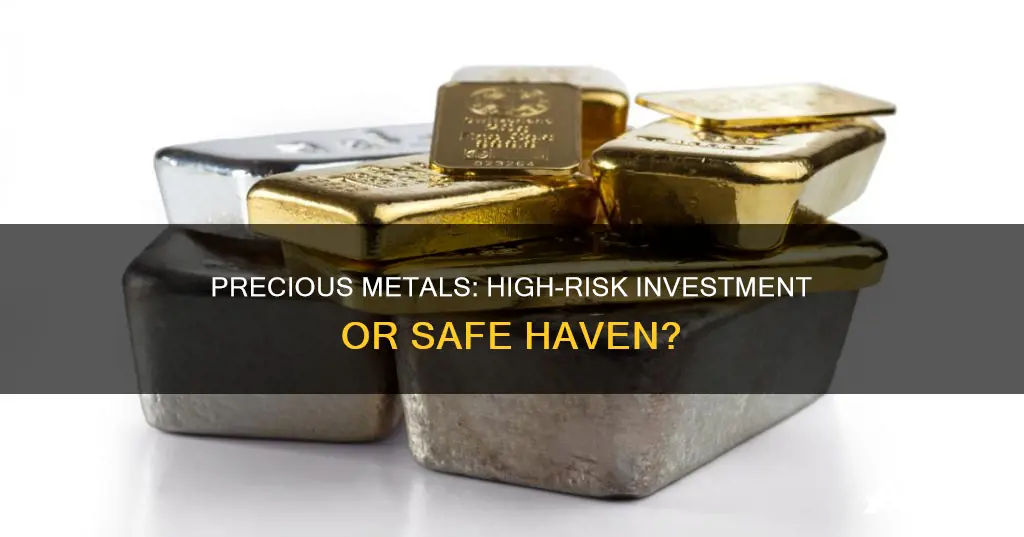
Precious metals like gold, silver, and platinum are considered safe investments during economic uncertainty. Their value is enduring, and they are seen as a hedge against inflation. However, like any investment, they come with risks. For instance, their prices can be influenced by various factors, including economic conditions, interest rates, and currency fluctuations. This can lead to price volatility, which is a significant risk. Other challenges include storage and insurance costs, liquidity concerns, and potential fraud. Therefore, while precious metals can provide stability, they are not risk-free, and investors need to understand the potential benefits and drawbacks before investing.
| Characteristics | Values |
|---|---|
| Inflation hedge | Precious metals prices tend to rise at or above the inflation rate |
| Tangible asset | Precious metals are real assets that hold value beyond investment purposes |
| Liquidity | Precious metals are fairly liquid investments |
| Portfolio diversification | The price movements of precious metals don't always align with the stock or bond markets |
| Storage and insurance costs | There are costs associated with storing and insuring physical precious metals |
| Theft | Physical precious metals are at risk of theft |
| Taxation | Precious metals sold at a profit are taxed as collectibles, which is higher than capital gains tax rates |
| No income generation | Precious metals do not generate income |
| Price volatility | Several factors can drive precious metals prices, including economic indicators, Federal Reserve policy, investor demand, mining supply, and inflation |
| Industrial demand | Silver and platinum's prices are influenced by industrial demand, which can fluctuate based on economic conditions and technological advancements |
| Storage considerations | Storing physical silver and platinum can be bulky and costly, especially for larger quantities |
| Affordability | Silver is more affordable than gold, making it accessible to a wider range of investors |
| Supply constraints | Platinum is a rare metal with limited production, which can lead to supply constraints and price appreciation |

Market volatility
For example, during economic uncertainty or geopolitical tension, investors often seek out gold as a safe haven, driving up its price. Conversely, when economic stability returns or interest rates rise, the appeal of non-yielding assets like gold may diminish, causing a decrease in price.
Silver and platinum, while also valuable, tend to be even more volatile than gold due to their industrial uses. Changes in industrial demand, technological advancements, or shifts in manufacturing can all impact the prices of these metals. For instance, silver's role in solar panels, electronics, and other electrical applications can affect its market value. Similarly, platinum's importance in the automotive industry for catalytic converters influences its price.
It's important to recognise that precious metals are subject to the same market forces as any other investment. Understanding and preparing for potential price swings can be crucial for effectively managing precious metal investments. Staying informed about global economic trends and market volatility can assist investors in making more strategic decisions regarding their precious metal assets.
While precious metals can provide a level of stability in a diversified portfolio, investors must consider the potential for price volatility and its impact on their overall investment strategy.
Investment Management: Adding Value, Growing Client Wealth
You may want to see also

Storage and security
When investing in physical precious metals, storage and insurance are critical considerations. Unlike digital investments, physical gold requires a secure location for storage, which can present logistical and financial challenges. While storing gold at home may seem convenient, it carries significant risks. Home safes offer some protection, but they are not foolproof, and the threat of theft or damage remains. Additionally, the responsibility for ensuring adequate security typically falls on the investor, and investing in high-quality safes or security systems incurs additional costs.
For those who prefer not to store precious metals at home, professional storage solutions are available. For example, The Royal Mint offers secure storage options through The Vault®, where individuals can safely hold gold and other precious metals. These services protect investments from theft and damage while relieving investors of security management burdens. Professional storage services often include comprehensive insurance coverage, protecting investments from potential risks such as theft, loss, or damage. However, it is important to note that storage and insurance services come with fees and potential liabilities or insurance exclusions, impacting the overall ongoing costs of the investment.
When considering storage options, individuals can choose between storing precious metals at home, in a bank safe deposit box, or in a vault. Storing precious metals at home provides the highest level of control and accessibility. However, the possibility of theft, natural disasters, or misplacement should be carefully considered. On the other hand, banks are less likely to experience aggravated burglary compared to homes, and safety deposit boxes offer a secure and climate-controlled environment. Additionally, banks provide top-notch internal and external security.
Another modern alternative is to utilise a precious metals depository, which offers top-tier, expert security measures. Depositories provide specialised storage facilities with advanced security measures, including 24/7 surveillance, controlled access, and state-of-the-art security systems. They also ensure compliance with regulatory standards and facilitate the transportation of precious metals. The services offered by depositories include segregated or allocated storage, titles, insurance, and transportation.
When selecting a storage option, it is essential to consider factors such as security, accessibility, protection against potential risks, and insurance coverage. Implementing security measures such as alarm systems, surveillance cameras, and smart locks can enhance the protection of precious metals. Diversifying storage locations by storing portions of precious metals in different places can also provide an added layer of security. Obtaining comprehensive insurance coverage is crucial, regardless of the chosen storage option, to safeguard against potential loss, theft, or damage.
India's Investment Appeal: Why Countries Want a Piece
You may want to see also

Liquidity
Physical gold, such as bars or coins, can be sold relatively quickly. However, the process may involve finding a reputable dealer, authenticating the metal, and negotiating a fair price. There may also be premiums or discounts applied depending on market conditions, impacting the final sale price. The trading format, dealer, and volume purchased can also affect fees and commissions, which can be as high as 5% of the traded amount.
On the other hand, digital precious metals, such as The Royal Mint's DigiGold, offer greater liquidity with lower transaction costs and faster settlement times.
When investing in precious metals, it is essential to consider your liquidity needs and how quickly you may need to access funds. Balancing physical and digital options within your portfolio can provide flexibility and ensure you can respond to changing financial circumstances.
Gold has the largest and most liquid market among precious metals. Silver is also highly liquid but has experienced more significant price swings due to attempts by large players to influence the market. Platinum, on the other hand, has a smaller market and is therefore less liquid than gold or silver.
In terms of investment portfolios, precious metals like gold, silver, and platinum are generally more liquid than lesser-known precious metals, making them less risky. This is because they are more widely recognised, sought-after, and traded, making them easier to buy and sell.
Overall, while precious metals like gold are considered liquid assets, the liquidity of your investment will depend on factors such as the form of the metal, market conditions, and the trading format.
Understanding the Role of a 3(38) Investment Manager
You may want to see also

Tax implications
The tax implications of investing in precious metals vary depending on the jurisdiction. For instance, in the US, the Internal Revenue Service (IRS) classifies gold and silver as collectibles, so long-term capital gains are taxed at a maximum rate of 28%. This means that individuals in the 32%, 35%, and 37% ordinary income tax brackets only have to pay 28% on their physical precious metals sales. On the other hand, short-term gains from precious metals held for one year or less are taxed at ordinary income rates, which can be significantly higher. For example, the 37% rate applies to incomes of more than $626,350 for single taxpayers in tax year 2025 and over $751,600 for married taxpayers filing joint returns.
In the UK, gold, silver, and platinum coins produced by The Royal Mint, such as The Sovereign and Britannia, are exempt from Capital Gains Tax (CGT) as they are considered legal tender. However, other forms of gold, silver, and platinum investments may be subject to taxes on gains.
When investing in precious metals, it is crucial to understand the specific tax rules that apply to your jurisdiction and the type of investment you are making. Consulting with a tax advisor is always recommended to ensure compliance and optimize your tax planning.
Additionally, it is important to note that the cost basis of gold and silver investments includes the purchase price plus any associated costs such as dealer premiums and storage fees, which will reduce the taxable gain when you sell them. Proper record-keeping of these expenses, as well as purchase and sale prices, is essential for accurate reporting on tax returns.
Furthermore, losses from gold and silver investments can generally be used to offset other capital gains, potentially reducing your overall tax liability. In the US, if your losses exceed your gains, you can use up to $3,000 of the excess loss to offset other income, and any remaining loss can be carried forward to future years.
Investment Management: Wealth, Assets, and You
You may want to see also

Counterparty risk
Direct Ownership of Physical Metals
Direct ownership of physical precious metals, such as gold or silver bars and coins, typically carries minimal counterparty risk. This is because you hold the asset directly, and its value is not dependent on someone else's promise or ability to pay. However, if you store these metals with a third party, such as a bank or private storage facility, there is a counterparty risk associated with the storage provider. Your assets could be at risk if the provider faces financial difficulties, insolvency, or operational issues.
Precious Metal Certificates
Certificates represent ownership of a specific quantity of precious metals held by a third party. The counterparty risk here lies with the issuer's ability to fulfil their obligation to deliver the physical metal upon request or accurately represent its existence and ownership.
Precious Metals ETFs (Exchange-Traded Funds)
These financial instruments track the price of precious metals and are traded on stock exchanges. The counterparty risk is associated with the fund's management and the solvency of the institution backing the ETF. If the managing entity faces financial issues or mismanages the fund, it could negatively impact your investment.
Investing in Stocks of Mining Companies
Investing in the stocks of companies that mine precious metals introduces counterparty risk related to the company's operational and financial performance. If the mining company underperforms, faces regulatory issues, or goes bankrupt, the value of your investment could decrease significantly.
Futures and Options Contracts
These are derivative instruments that derive their value from the underlying precious metal. The counterparty risk here involves the possibility of the other party in the contract not fulfilling their obligations, such as delivering the metal or settling in cash as per the contract terms.
Digital or Cryptocurrency Backed by Precious Metals
When investing in digital or cryptocurrency backed by precious metals, the counterparty risk involves the issuer's ability to back each digital token with physical metal and the overall integrity of their operations.
To protect your precious metals investments from counterparty risk, it is essential to conduct thorough due diligence, diversify your portfolio, and understand the risks associated with each investment type. Opting for direct ownership of physical metals and choosing reputable and insured providers can help minimise counterparty risk.
Understanding Investment Portfolio Activity: A Beginner's Guide
You may want to see also
Frequently asked questions
All investments carry some form of risk, and precious metals are no exception. While precious metals like gold, silver, and platinum are often seen as safe havens during economic downturns, their prices can be influenced by various factors, including economic conditions, industrial demand, geopolitical tensions, and market forces. Therefore, investors should carefully consider their risk tolerance and investment objectives before including precious metals in their portfolios.
One of the primary risks is price volatility or market risk. Precious metal prices can fluctuate significantly due to economic indicators, geopolitical events, investor sentiment, and supply and demand dynamics. Another risk is liquidity risk, where investors may face challenges in selling their precious metals, especially during economic crises. Storage and security are also important considerations, as physical precious metals require secure storage, which can incur additional costs.
Precious metals offer a hedge against inflation, preserving wealth during economic uncertainty. They also provide portfolio diversification, reducing overall volatility. Additionally, precious metals have a long history of maintaining their value over time and are sought after for their intrinsic value, industrial uses, and symbolism of wealth.
There are several ways to invest in precious metals, including buying physical assets such as coins or bars, investing in exchange-traded funds (ETFs) or mutual funds, purchasing stock in precious metal mining companies, or investing in precious metal certificates. Each option has its own set of risks and considerations.
The most common precious metals for investment are gold, silver, and platinum. However, other metals like palladium, rhodium, ruthenium, iridium, and osmium are also considered precious and may offer investment opportunities. Gold is known for its durability, shaping capability, and heat and electrical conductivity, while silver and platinum have significant industrial applications.







